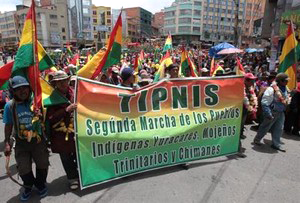 On 7 December 2012 a 5-month consultation about a proposed highway to be built through Bolivia’s Isiboro Secure National Park and Indigenous Territory (TIPNIS) came to an end. Of the territory’s 69 indigenous communities, 55 approved the highway, three communities rejected the proposal and 11 refused to participate in the consultation.
On 7 December 2012 a 5-month consultation about a proposed highway to be built through Bolivia’s Isiboro Secure National Park and Indigenous Territory (TIPNIS) came to an end. Of the territory’s 69 indigenous communities, 55 approved the highway, three communities rejected the proposal and 11 refused to participate in the consultation.
TIPNIS is an area of more than 1 million hectares of forest in the centre of Bolivia. It is home to 12,000 people living in 69 separate communities. In 2009 Evo Morales’ Movement Towards Socialism (MAS) government designated it ‘indigenous territory’.
The proposed highway will cross north-south through TIPNIS for 32 miles of its 182-mile route. It will be the first paved road linking northwest Bolivia with the economic centre, Santa Cruz. It will mean greater access to health and education for the TIPNIS population and reduced barriers to economic development. In particular it will undermine the monopoly of Santa Cruz-based businesses in terms of access to processing goods and distributing them to the rest of the country. It is no coincidence that the Confederation of Indigenous Peoples of Bolivia (CIDOB), which supported protests against the highway, has strong links with the right-wing governor of Santa Cruz and signed an agreement guaranteeing CIDOB a place on the governership.
Nevertheless the resistance to the highway was fuelled by legitimate concerns about environmental damage and an initial lack of consultation with TIPNIS communities. Protests culminated in August 2011 with a march from TIPNIS to La Paz. This caused the government to shelve plans and pass a law declaring the territory ‘untouchable’. However, a debate subsequently opened up over the balance between environmental protection and the need for development in Bolivia. CONISUR (Consejo de Indigenas del Sur), a coalition of TIPNIS residents in support of the highway project, organised marches in favour. This led to the launch of the independent consultation.
The consultation result is a victory for the Morales government and demonstrates its commitment to building consensus. In response to concerns over deforestation, the Morales government has said it will introduce jail terms of 10-20 years for illegal settlements, coca growing or logging in the national park.
International response
Despite the complex nature of the debate, many international commentators uncritically supported the anti-highway protests. Their responses were simplistic and lent support to imperialism’s attempts to drive a wedge between Bolivia’s social movements and MAS.
In an article in International Socialism, theoretical journal of the Socialist Workers Party, Jeffery Webber cited the TIPNIS issue as an example of what he sees as a continuation of neoliberal policies. In a response in the same journal, Frederico Fuentes, writer and editor of boliviarising.blogspot.co.uk, gives a strong rebuttal of this claim. For example, as part of Webber’s characterisation of the government as neoliberal, he dismisses its agrarian reform as ‘inconsequential’ but, as Fuentes points out, 41 million hectares of land being redistributed to 900,000 members of indigenous peasant communities between 2005 and 2010 is not inconsequential. This is just one fact that Fuentes uses to show that the MAS programme is anything but neoliberal, as Webber asserts.
In September 2011 a group of 60 NGOs signed a letter to Morales condemning the highway plan. International campaign organisation Avaaz presented the issue as a straightforward attack on indigenous people, ignoring the debate within Bolivia. Furthermore, at the time these calls went out, the TIPNIS marchers against the highway included reactionary policies in their set of demands, which were supported by these NGOs.
Firstly, they were calling for an end to fossil fuel extraction in another national park, Aguarague. Considering that gas fields there represent 90% of Bolivia’s gas reserves this would dramatically reduce the Bolivian state’s spending power overnight. Rather than protecting the environment, it would reverse the progressive gains of the last 7 years and make Bolivia subservient to international capital again, with all the damage to Bolivia’s natural assets that would entail.
Another demand was to convert Bolivia’s forests into carbon credits, putting them under the control of foreign capital, while allowing polluters elsewhere to ‘offset’ their pollution against them. This scheme, which would only serve to increase carbon emissions, was promoted by international NGOs with funding by USAID, for example for running workshops and training for CIDOB. USAID is an infamous channel of funds used by the US to destabilise countries that challenge US imperialism, for example Cuba. The involvement of USAID is consistent with US diplomatic cables released by Wikileaks showing that USAID money is purposefully targeted at indigenous groups in Bolivia to undermine support for the government.
The highway project must be seen in the context of the MAS government’s programme to take state control over natural resources, invest in the national economy and raise living standards. The achievements so far, made possible by and responding to the mass movement, show clearly that it does represent a break with neoliberalism. Simplistic formulas that cast the rights of indigenous people as inherently incompatible with this process are misleading and dangerous.
Sam Vincent




